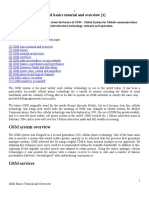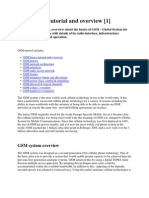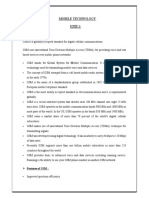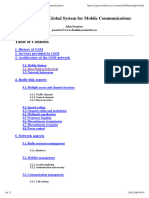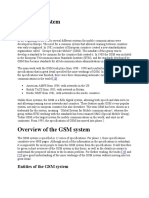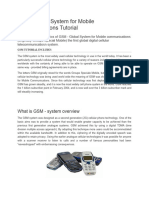Global System For Mobile: Vinay Sahu
Global System For Mobile: Vinay Sahu
Uploaded by
Vinay SahuCopyright:
Available Formats
Global System For Mobile: Vinay Sahu
Global System For Mobile: Vinay Sahu
Uploaded by
Vinay SahuOriginal Description:
Original Title
Copyright
Available Formats
Share this document
Did you find this document useful?
Is this content inappropriate?
Copyright:
Available Formats
Global System For Mobile: Vinay Sahu
Global System For Mobile: Vinay Sahu
Uploaded by
Vinay SahuCopyright:
Available Formats
Global System for Mobile
Vinay Sahu
Department of Electronics and Communication Lovely Professional University, Phagwara
Abstract A connection between two people- a caller and called person is the basic service of the telephone system. To provide this service, the network must be able to set up and maintain a call, which involves a number of tasks: identifying the called person, determining the location and ensuring that the connection is sustained as long as the conversation lasts. This paper provides the basic ideas of GSM, history and its working process with architecture of GSM. Introduction Tremendous changes are taking place in the arena of mobile technologies, and the worldwide push toward 3rd generation services is currently at the forefront of these transformations. Many questions surround the concept of 3G not only in terms of what it means and what services it will offer, but also in terms of how to get there, which standard will be dominant, how long it will take to deploy, and whether it will be as lucrative as expected given the current rush of exorbitant spectrum fees[5]. This case study is designed to examine some of these questions about 3G from the analytical perspective of predecessor 2nd generation technologies, and specifically of GSM in Europe. The successful development and deployment of GSM over the past two decades is most significant, if one is to accept the hypothesis that experience counts in the mobile arena.
The deployment of GSM is most aptly characterized by the commitment of twentysix European national phone companies to standardize a system, and the working process responsible for this accomplishment has been deemed a great success worthy of replication. Essentially, those countries and firms involved realized the advantages of a cross-border standard and the amount of money and energy that can be wasted when competing for mobile technology world domination. Generally speaking, the story of the establishment of GSM is of interest to anybody studying the growth and trajectory of digital technology and its commercial applications. The Generations of Mobile Networks The idea of cell-based mobile radio systems appeared at Bell Laboratories in the United States in the early 1970s. However, mobile cellular systems were not introduced for commercial use until a decade later. During the early 1980s, analog cellular telephone systems experienced very rapid growth in Europe, particularly in Scandinavia and the United Kingdom. Today, cellular systems still represent one of the fastest growing telecommunications systems[3]. First-generation cellular networks, the primary focus of the communications industry in the early 1980s, were characterized by a few compatible systems that were designed to provide purely local
cellular solutions. It became increasingly apparent that there would be an escalating demand for a technology that could facilitate flexible and reliable mobile communications. By the early 1990s, the lack of capacity of these existing networks emerged as a core challenge to keeping up with market demand. The first mobile wireless phones utilized analog transmission technologies, the dominant analog standard being known as AMPS, (Advanced Mobile Phone System). Analog standards operated on bands of spectrum with a lower frequency and greater wavelength than subsequent standards, providing a significant signal range per cell along with a high propensity for interference.4 Nonetheless, it is worth noting the continuing persistence of analog (AMPS) technologies in North America and Latin America through the 1990s[2]. Initial deployments of second-generation wireless networks occurred in Europe in the 1980s. These networks were based on digital, rather than analog technologies, and were circuit-switched. Circuit-switched cellular data is still the most widely used mobile wireless data service. Digital technology offered an appealing combination of performance and spectral efficiency (in terms of management of scarce frequency bands), as well as the development of features like speech security and data communications over high quality transmissions. It is also compatible with Integrated Services Digital Network (ISDN) technology, which was being developed for land-based telecommunication systems throughout the world, and which would be necessary for GSM to be successful. Moreover in the digital world, it would be possible to employ very large-scale integrated silicon technology to make handsets more affordable[2].
However, second-generation equipment has since proven to offer many advantages over analog systems, including efficient use of radio-magnetic spectrum, enhanced security, extended battery life, and data transmission capabilities. There are four main standards for 2G networks: Time Division Multiple Access (TDMA), Global System for Mobile Communications (GSM) and Code Division Multiple Access (CDMA). A Look Back at GSM One of the most important conclusions from the early tests of the new GSM technology was that the new standard should employ Time Division Multiple Access (TDMA) technology. With global coverage goals in mind, being compatible with GSM from day one is a prerequisite for any new system that would add functionality to GSM. As with other 2G systems, GSM handles voice efficiently, but the support for data and Internet applications is limited. A data connection is established in just the same way as for a regular voice call; the user dials in and a circuit-switched connection continues during the entire session. If the user disconnects and wants to re-connect, the dial-in sequence has to be repeated. This issue, coupled with the limitation that users are billed for the time that they are connected, creates a need for packet data for GSM[4]. The digital nature of GSM allows the transmission of data (both synchronous and asynchronous) to or from ISDN terminals, although the most basic service support by GSM is telephony.17 Speech, which is inherently analog, has to be digitized. The method employed by ISDN, and by current telephone systems for multiplexing voice lines over high-speed trunks and optical fiber lines[5].
(MS) and the base station (BS). This openair interface is appropriately named the air interface. The second interface is located between the mobile service switching center (MSC) and the base station controller (BSC). In a GSM architecture the decentralized intelligence is implemented by dividing the whole network into three separate subsystem: a. Network Switching Subsystem (NSS). b. Base Station Subsystem (BSS). c. Operation Support Subsystem (OSS). The actual network needed for establishing call is composed of the NSS and BSS. The BSS is responsible for radio path control and every call is connected through the BSS. The NSS takes care of call control function. Calls are always connected by and through the NSS. The OSS is the operation and maintenance related part of the network and it is needed for control of the whole GSM network. The network operator observes and maintains network quality and service offered through the OSS[1].
Figure: 1
A unique feature of GSM is the Short Message Service (SMS), which has achieved wide popularity as what some have called the unexpected killer application of GSM. SMS is a bi-directional service for sending short alphanumeric message in a store-andforward process. SMS can be used both point-to-point as well as in cell-broadcast mode[2][1][4]. Another of GSMs most attractive features is the extent to which its network is considered to be secure. All communications, both speech and data, are encrypted to prevent eavesdropping, and GSM subscribers are identified by their Subscriber Identity Module (SIM) card (which holds their identity number and authentication key and algorithm). GSM Architecture Here firstly I will explain about open interface of GSM, which then limit certain parts of GSM system. Because of this interface openness, the operator maintaining the network may obtain different parts of the network from different GSM network suppliers[4]. The GSM specifications define two truly open interfaces within the GSM network. The first one is between the mobile station
Figure: 2
NSS consists various registers like; The Home Location Register (HLR) and Visitor Location Register (VLR), together with the
MSC, provide the call-routing and roaming capabilities of GSM. The HLR contains all the administrative information of each subscriber registered in the corresponding GSM network, along with the current location of the mobile. The location of the mobile is typically in the form of the signaling address of the VLR associated with the mobile station. The actual routing procedure will be described later. There is logically one HLR per GSM network, although it may be implemented as a distributed database. The Visitor Location Register (VLR) contains selected administrative information from the HLR, necessary for call control and provision of the subscribed services, for each mobile currently located in the geographical area controlled by the VLR. Although each functional entity can be implemented as an independent unit, all manufacturers of switching equipment to date implement the VLR together with the MSC, so that the geographical area controlled by the MSC corresponds to that controlled by the VLR, thus simplifying the signaling required. Note that the MSC contains no information about particular mobile stations --- this information is stored in the location registers[3]. The other two registers are used for authentication and security purposes. The Equipment Identity Register (EIR) is a database that contains a list of all valid mobile equipment on the network, where each mobile station is identified by its International Mobile Equipment Identity (IMEI). An IMEI is marked as invalid if it has been reported stolen or is not type approved. The Authentication Center (AuC) is a protected database that stores a copy of the secret key stored in each subscriber's
SIM card, which is used for authentication and encryption over the radio channel. GSM Radio Spectrum The ITU, which manages the international allocation of radio spectrum, allocated the 890-915 MHz bands for the uplink (mobile station to base station) and 935-960 MHz bands for the downlink (base station to mobile station) for mobile networks in Europe. Since this range was already being used in the early 1980s by the analog systems of the day, the CEPT had the foresight to reserve the top 10 MHz of each band for the GSM network that was still being developed. A duplex transmission is realized in a Frequency Division Duplex (FDD) mode. Both bands are divided into 124 frequency intervals of 200 kHz each with carrier frequencies in their centers. Time along each carrier is divided into 8 slots. Thus, multiple access is realized through assigning the connection a particular carrier frequency (or a sequence of them if frequency hopping is performed) and a selected time slot. As a result, the GSM can be treated as a system with TDMA/FDMA multiple access scheme[3][4]. Conclusion
To a large extent, GSM can be said to have been the right system at the right place at the right time
In this paper I have tried to give an overview of the GSM system. As with any overview, and especially one covering a standard 6000 pages long, there are many details missing. I believe, however, that I gave the general flavor of GSM and the philosophy behind its design. It was a monumental task that the original GSM committee undertook, and one that has proven a success, showing that international cooperation on such projects
between academia, industry, and government can succeed. It is a standard that ensures interoperability without stifling competition and innovation among suppliers, to the benefit of the public both in terms of cost and service quality. For example, by using Very Large Scale Integration (VLSI) microprocessor technology, many functions of the mobile station can be built on one chipset, resulting in lighter, more compact, and more energyefficient terminals. Telecommunications are evolving towards personal communication networks, whose objective can be stated as the availability of all communication services anytime, anywhere, to anyone, by a single identity number and a pocket able communication terminal. Having a multitude of incompatible systems throughout the world moves us farther away from this ideal. The economies of scale created by a unified system are enough to justify its implementation, not to mention the convenience to people of carrying just one communication terminal anywhere they go, regardless of national boundaries.
[5] Gozalvez Sempere, Javier. Overview of the GSM System.
An
References [1] A. Mehrotra, GSM System Engineering, Artech House Publishers, Boston, 1997. [2] Theodore S., Wireless Communication principles and practice. [3] C. K Toh Ad Hoc Wireless Networks, Published by Dorling Kindersley. [4] Godell, Lars. Europes UMTS Meltdown. Forrester Research Report.
You might also like
- Comviva Corporate Deck-April2019Document33 pagesComviva Corporate Deck-April2019Sundeep Mehta100% (1)
- GSM System OverviewDocument12 pagesGSM System Overviewvemala vandanaNo ratings yet
- Essential 4G Guide: Learn 4G Wireless In One DayFrom EverandEssential 4G Guide: Learn 4G Wireless In One DayRating: 4.5 out of 5 stars4.5/5 (12)
- Global System FOR Mobile Communication: A Seminar Report OnDocument10 pagesGlobal System FOR Mobile Communication: A Seminar Report Onkokilla100% (1)
- GSM Paper Presentation On Frequency PlanningDocument5 pagesGSM Paper Presentation On Frequency PlanningphalanetraNo ratings yet
- 1 - Introduction and Motivation: Evolving of Technology To 4G WirelessDocument13 pages1 - Introduction and Motivation: Evolving of Technology To 4G WirelessSalma SwaidanNo ratings yet
- GSM 1Document14 pagesGSM 1itdep_gpcet7225No ratings yet
- Evol Ution of CH Arging and Bil L Ing Model S For GSM and Future M Obil e Inte Rne T Se Rvice SDocument13 pagesEvol Ution of CH Arging and Bil L Ing Model S For GSM and Future M Obil e Inte Rne T Se Rvice SrajeshembeddedNo ratings yet
- GSM Basics Tutorial and OverviewDocument80 pagesGSM Basics Tutorial and OverviewBusari AbbasNo ratings yet
- Overview of The Global System For Mobile CommunicationsDocument25 pagesOverview of The Global System For Mobile Communicationszaid_asiaNo ratings yet
- Overview of The Global System For Mobile CommunicationsDocument25 pagesOverview of The Global System For Mobile Communicationsaytacerd0% (1)
- Fundamentals of GSMDocument16 pagesFundamentals of GSMKalai SelvanNo ratings yet
- Global System For Mobile CommunicationDocument7 pagesGlobal System For Mobile CommunicationDeepak100% (1)
- Wireless Communication: An OverviewDocument10 pagesWireless Communication: An Overviewmihir_damNo ratings yet
- GSM Basics Tutorial and OverviewDocument81 pagesGSM Basics Tutorial and OverviewMwai Janna100% (1)
- GSM Basics Tutorial and OverviewDocument60 pagesGSM Basics Tutorial and OverviewTariq KhurshaidiNo ratings yet
- Unit-4 (Wireless Communication)Document15 pagesUnit-4 (Wireless Communication)Anonymous EjQbY1CNo ratings yet
- Mobile TechnologyDocument18 pagesMobile TechnologyLady BugNo ratings yet
- GSM OverviewDocument18 pagesGSM Overviewchandunandamuri8940No ratings yet
- GSM ARchDocument30 pagesGSM ARchankitbirdiNo ratings yet
- Introduction To GSM, The Global System For Mobile Communication 1. Introduction: The Evolution of Mobile Telephone SystemsDocument9 pagesIntroduction To GSM, The Global System For Mobile Communication 1. Introduction: The Evolution of Mobile Telephone SystemsMaulin AminNo ratings yet
- Overview of The GSM CommunicationsDocument18 pagesOverview of The GSM CommunicationsronyiutNo ratings yet
- Term Paper Report On Comparative Analysis of GSM, GPRS, PCS, UMTS and IS-95. Submitted To MRDocument14 pagesTerm Paper Report On Comparative Analysis of GSM, GPRS, PCS, UMTS and IS-95. Submitted To MRayubNo ratings yet
- GSM System TuterialxDocument90 pagesGSM System Tuterialxមាស ចាន់ដារ៉ូNo ratings yet
- Hijack & DoS GSMDocument17 pagesHijack & DoS GSMResearch Guy100% (1)
- Chapter 4Document12 pagesChapter 4Nandhini PNo ratings yet
- The GSM Network ArchitectureDocument21 pagesThe GSM Network Architecturecharizsandraramos100% (2)
- Technical DetailsDocument6 pagesTechnical DetailsShamim AhmedNo ratings yet
- Overview of The GSMDocument17 pagesOverview of The GSMnovan wijayaNo ratings yet
- John Scourias: A Brief Overview of GSM, byDocument14 pagesJohn Scourias: A Brief Overview of GSM, bymohsinakram1No ratings yet
- Appraisal of Global System For Mobile Communication (GSM) in NigeriaDocument6 pagesAppraisal of Global System For Mobile Communication (GSM) in NigeriaAJER JOURNALNo ratings yet
- Term Paper OF: Global System For Mobile Communication (GSM)Document18 pagesTerm Paper OF: Global System For Mobile Communication (GSM)amitmaheshpurNo ratings yet
- Location Leaks On The GSM Air InterfaceDocument13 pagesLocation Leaks On The GSM Air InterfacessthakurNo ratings yet
- GSM Switching Services and Protocols p1 8309Document8 pagesGSM Switching Services and Protocols p1 8309Tam Mao0% (1)
- AND Bandwidth ManagementDocument20 pagesAND Bandwidth ManagementHephzibah MunnangiNo ratings yet
- Entities of The GSM SystemDocument18 pagesEntities of The GSM Systemhieuvnp3No ratings yet
- GSM: Global System For Mobile Communications TutorialDocument42 pagesGSM: Global System For Mobile Communications TutorialAstha SinghNo ratings yet
- Marconi S Innovative Perception of Electromagnetic Waves and The AirDocument11 pagesMarconi S Innovative Perception of Electromagnetic Waves and The AirVishal IyerNo ratings yet
- Forensics and The GSM Mobile Telephone System: International Journal of Digital Evidence Spring 2003, Volume 2, Issue 1Document17 pagesForensics and The GSM Mobile Telephone System: International Journal of Digital Evidence Spring 2003, Volume 2, Issue 1BEALogicNo ratings yet
- Getting To Know Wireless Networks and TechnologyDocument13 pagesGetting To Know Wireless Networks and TechnologyBijay SinghNo ratings yet
- GSM Network Architecture: GSM (Global System For Mobile)Document5 pagesGSM Network Architecture: GSM (Global System For Mobile)mard gharibNo ratings yet
- Tutorial GSMDocument27 pagesTutorial GSMVale MilesNo ratings yet
- Cellular Network ArchitectureDocument7 pagesCellular Network ArchitectureArul DeepaNo ratings yet
- Chapter-1 Wireless Communication System: 1.1 Brief History of Cellular NetworksDocument62 pagesChapter-1 Wireless Communication System: 1.1 Brief History of Cellular NetworksNijanthan BharathNo ratings yet
- Mobile Networks TutorialDocument28 pagesMobile Networks TutorialGSM-ITU100% (2)
- GSM: Global System For Mobile Communications TutorialDocument5 pagesGSM: Global System For Mobile Communications Tutorialasim204No ratings yet
- Introduction To GSM: TechnologyDocument60 pagesIntroduction To GSM: TechnologyMamadu BahNo ratings yet
- Overview of The Global System For Mobile CommunicationsDocument25 pagesOverview of The Global System For Mobile CommunicationsLiyang ChangNo ratings yet
- Security Model Evaluation of 3G Wireless NetworksDocument15 pagesSecurity Model Evaluation of 3G Wireless NetworksAbolaji OkikiadeNo ratings yet
- Seminar Supervisor D.Venu Name: Narlagiri Vamshi Assistant Professor, Dept. of ECE Class: Iii Ece-Ii Roll No: B17EC090Document1 pageSeminar Supervisor D.Venu Name: Narlagiri Vamshi Assistant Professor, Dept. of ECE Class: Iii Ece-Ii Roll No: B17EC090Vamshi NarlagiriNo ratings yet
- CDMA Vs GSMDocument20 pagesCDMA Vs GSMKrati SethNo ratings yet
- Modeling and Dimensioning of Mobile Wireless Networks: From GSM to LTEFrom EverandModeling and Dimensioning of Mobile Wireless Networks: From GSM to LTENo ratings yet
- The International Telecommunications Regime: Domestic Preferences And Regime ChangeFrom EverandThe International Telecommunications Regime: Domestic Preferences And Regime ChangeNo ratings yet
- Cellular Technologies for Emerging Markets: 2G, 3G and BeyondFrom EverandCellular Technologies for Emerging Markets: 2G, 3G and BeyondNo ratings yet
- Self-Organizing Networks: Self-Planning, Self-Optimization and Self-Healing for GSM, UMTS and LTEFrom EverandSelf-Organizing Networks: Self-Planning, Self-Optimization and Self-Healing for GSM, UMTS and LTEJuan RamiroNo ratings yet
- LTE Self-Organising Networks (SON): Network Management Automation for Operational EfficiencyFrom EverandLTE Self-Organising Networks (SON): Network Management Automation for Operational EfficiencySeppo HämäläinenNo ratings yet
- Diseases of The Oesophagus:2011: Esophageal Motility DisorderDocument13 pagesDiseases of The Oesophagus:2011: Esophageal Motility DisorderIrakiza jean jacques100% (1)
- Dionne Bartley ResumeDocument3 pagesDionne Bartley Resumeapi-285419812No ratings yet
- Helios PDF HandshakeDocument2 pagesHelios PDF HandshakemilivojNo ratings yet
- A Simplified Method of Three Dimensional Technique For The Detection of AmpC Beta-LactamasesDocument7 pagesA Simplified Method of Three Dimensional Technique For The Detection of AmpC Beta-LactamasesInternational Medical PublisherNo ratings yet
- Project Report e Commerce Website AmityDocument15 pagesProject Report e Commerce Website AmityŁ2Kと HŸDRÂNo ratings yet
- Research Proposal FSDocument52 pagesResearch Proposal FSAdugna MisganawNo ratings yet
- C Sit 130211Document8 pagesC Sit 130211Shimaa AshrafNo ratings yet
- Long Term Performance of PVC Pressure PipesDocument6 pagesLong Term Performance of PVC Pressure PipesMuhammad AhmedNo ratings yet
- CHAPTER 4 Jacques LacanDocument18 pagesCHAPTER 4 Jacques LacanAlexandra Popescu100% (1)
- Mystery, Magic and Morals: Looking at Themes and Ideas in Select Indian and Arabic LiteratureDocument5 pagesMystery, Magic and Morals: Looking at Themes and Ideas in Select Indian and Arabic LiteratureIJELS Research JournalNo ratings yet
- Ec 53Document2 pagesEc 53Prince DevarajNo ratings yet
- Burnout, Compassion Fatigue and Psychological Capital Findings From ADocument9 pagesBurnout, Compassion Fatigue and Psychological Capital Findings From AElly RupangNo ratings yet
- 2017 CPT ICD10 Quick Reference 1Document8 pages2017 CPT ICD10 Quick Reference 1amruthkiranbabujiNo ratings yet
- Healthy Diet Plan: Meal Time Food Option With QuantityDocument2 pagesHealthy Diet Plan: Meal Time Food Option With QuantitySravan Kumar ReddyNo ratings yet
- Question Bank BA HeadDocument6 pagesQuestion Bank BA Headseshu_baluNo ratings yet
- UPS Dynasty BatteriesDocument6 pagesUPS Dynasty BatteriesbandarbadhonNo ratings yet
- E Cosmetics Rules, 2020Document64 pagesE Cosmetics Rules, 2020Aby BabyNo ratings yet
- The Kinetic Theory of GasesDocument91 pagesThe Kinetic Theory of GasesEbony Edwards100% (1)
- Sharepoint 2013 Architecture OverviewDocument1 pageSharepoint 2013 Architecture OverviewStefano LorenzoNo ratings yet
- Quantitative Methods For Management (JANUARY-MARCH 2021) : Assignment Answer All The Questions Max. Marks: 40Document4 pagesQuantitative Methods For Management (JANUARY-MARCH 2021) : Assignment Answer All The Questions Max. Marks: 40Georgekutty GeorgeNo ratings yet
- PDFDocument264 pagesPDFDragne DenisaNo ratings yet
- NSEB 2022 Question Paper With SolutionsDocument24 pagesNSEB 2022 Question Paper With Solutionspritishahdeo71725No ratings yet
- Biodiversity StudyDocument118 pagesBiodiversity StudyAndrea Lizares Si100% (1)
- TR90 Product PIPagesDocument6 pagesTR90 Product PIPagesaenylevyNo ratings yet
- Dissertation For Mba FinanceDocument4 pagesDissertation For Mba Financedipsekator1983100% (1)
- Action Plan On Upgrading and Updating of Als WebsiteDocument2 pagesAction Plan On Upgrading and Updating of Als Websiteelmer fabrosNo ratings yet
- 2019 Grav Course EafitDocument74 pages2019 Grav Course EafitEdwinNo ratings yet
- SMIS PathfinderDocument46 pagesSMIS PathfinderJiji Carinan - TaclobNo ratings yet
- Rmaniae (Classical Philology Xvi 1921)Document6 pagesRmaniae (Classical Philology Xvi 1921)Giacomo PediniNo ratings yet









